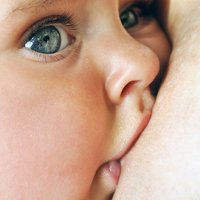Milk as a messenger
Human milk contains tiny structures that can carry messages from the mother’s cells to her infant’s cells. Scientists at Aarhus University have studied the structure and function of these nano-packages more closely.

With twitter, tablets and TV, we live in an information society. Did you know that milk can also act as a medium? Breast milk contains small structures that apparently can transport important messages from mother to child. Scientists at Aarhus University have developed a method that enables a closer look at these structures and their functions.
Breast milk contains a variety of important nutrients. Infant formula milk mimics the nutrient composition of breast milk and is given to children who for whatever reason are not breast-fed.
It is not just the nutrients, however, that make breast milk valuable. Breast milk also contains a number of bioactive ingredients that impart long-lasting health benefits to the infant. These substances are not to be found in the same way in formula milk.
- Children who have been breast-fed have been observed to gain certain advantages over children who have not been breast-fed. This is in areas such as growth, nutritional status, incidence of disease and composition of intestinal flora. Analyses of the long-term effects suggest that breast milk also lowers the risk of developing certain lifestyle diseases, says PhD fellow Kristine Blans from the Department of Molecular Biology and Genetics, Aarhus University.
Nano-sized messengers
In her PhD study she developed a preservative method to isolate and characterise the nanostructures in milk that apparently act as carriers of messages from mother to child.
The postal system of the milk is mediated by so-called extracellular vesicles that originate in the mother’s cells and are wrapped in a membrane. The purpose of developing a method to isolate the extracellular vesicles from the other milk components is to pave the way for studies of the possible health benefits of these nano-messengers.
- The tiny packages contain genetic messages and data that presumably help to develop the infant's immune system, explains Kristine Blans. She used fresh cow's milk and breast milk to investigate the diversity, structure and molecular composition of the extracellular vesicles.
- We found that milk contains many different types of extracellular vesicles. It is therefore likely that they carry various types of messages from mother cell to child cell. There are similarities in the molecular composition of the messages in cow's milk and breast milk, so the exchange of 'milk mail' between species cannot be excluded, says Kristine Blans.
The messages that the extracellular vesicles carry from mother to child consist, among other things, of sequences of nucleotides. Nucleotides are the building blocks of DNA. Due to their protective membrane, the messengers are acid-resistant, which means they can survive in the harsh, acidic environment of the stomach. It is therefore likely that such milk messages can be transferred to and affect our cells – including those from cow's milk.
Kristine Blans has found and isolated the milk hieroglyphs but the deciphering is yet to be done.
- We do not yet understand precisely what messages the extracellular vesicles deliver, but since the mail system is universal and similar messages are also transported in the blood, there are fortunately a lot of us at global level who are studying the purpose of the messages and their significance for the cells receiving them, says Kristine Blans.
The project was supported by Arla Foods Ingredients and the Danish Dairy Research Foundation.
For further information please contact:
PhD fellow Kristine Blans, Department of Molecular Biology and Genetics, e-mail: kimb@mbg.au.dk, telephone +45 2044 2773
Senior Scientist Jan Trige Rasmussen, Department of Molecular Biology and Genetics, e-mail: jatr@mbg.au.dk, telephone: +45 8715 5462
